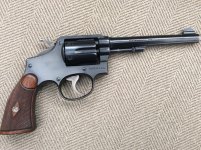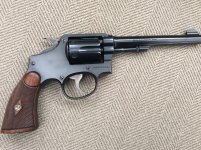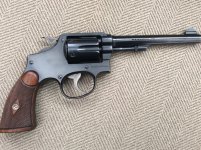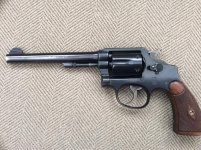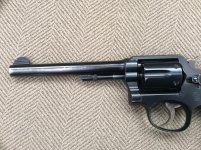In an effort to draw Holmes out of his funk, I dropped the revolver with a thud on his desk. “Here is my latest gun. What do you make of it?”
Holmes turned, his curiosity piqued. He picked up the gun, turning it over and over. He took his handkerchief and swabbed the barrel and a cylinder. He produced a small tool and used it to remove the grips. He viewed the gun again from all angles and then dry fired it. He smiled and put the gun next to his violin. “This gun, which you just purchased on Gunbroker, is a Smith & Wesson Military and Police model, circa 1926. It was purchased and owned by a fairly successful lawyer who used it for protection. He didn’t shoot much. He lost money in the crash of ‘29, but didn’t do himself in. The gun sat in his right desk drawer for over 40 years until his son acquired it. When the son died, his family sold the gun. You acquired it for a very reasonable sum.”
I started to gag on my tea. “What? Are you kidding? You’re making this all up. You’re guessing!! “
“Actually, my dear Thinnes, it’s elementary. It’s a simple matter of observation and deduction”.
“ I must confess”, I said, “that you are absolutely right on all accounts. The son’s wife gave me the full history of the gun and family. But tell me. I must know! How in the dickens do you know all this??
“Elementary, good chap. First of all, I saw the FedEx package you brought the gun in, and I know your buying habits. So Gunbroker was easy. You wouldn’t be showing me the gun if you thought you paid too much, so I deduced you got it for a rather small sum”.
“Fair enough,” I said. “What about the gun?”
“Yes, a bit more difficult. The barrel says 38 S&W special cartridge. It has a half moon front sight and a notch rear sight. It’s a Millitary & Police model. It carries no model number in the yoke and it has 5 screws, so it predates 1957. The serial number is 523592, which puts shipping date around 1926, prior to the big crash. It has the old one line address”.
“Yes, go on. The owner?”
“The gun is in 99% condition on the right side. The left side of the gun is a bit more worn, 90-95%. I suspect this gun sat for a very long time in a desk drawer on its left side, resulting in some wear on that side only. There are no holster markings. The owner wanted it available for protection. If sitting on its left side in the drawer, it was ready for a right handed grab. The gun was in the right desk drawer. The owner didn’t want to have to reach across his body and grope in the left drawer for access.”
“Go on”, I said, stunned.
“The man had the finances to buy a very good gun in 1926. He needed protection. Not a doctor or office worker, the owner was successful and wanted a gun for protection. Not an accountant, likely a lawyer. Someone who deals with upset people. Possibly a stockbroker. He never replaced the gun in the 1930’s when he could have purchased a Registered Magnum or a Heavy Duty. No, I think he had a change in finances. I believe he lost money in the crash and didn’t replace the gun. He may have thought about suicide but didn’t do it . There are no blood protein stains on the gun. Also remember, the gun was in the drawer for a very long time. I can tell that the gun was not shot very much. There is no turn line and only slight silvering at the muzzle. The grips are original to the gun. Convex, in very good shape. Diamond walnut. Very well cared for. This gun was not handled or shot much. The hammer and trigger retain vivid case coloring. The next owner also cared for the gun, almost cherishing it. A family member. I suspect a son had it next. Not a daughter. Why did the gun leave the family eventually? I suspect the son died and his family didn’t have the same connection to the gun as the son.
“Amazing”, I said, “just amazing”.
“Elementary observation and deductive reasoning, my good man. Now, let us try our luck with your new weapon at the range”.
The end?
Holmes turned, his curiosity piqued. He picked up the gun, turning it over and over. He took his handkerchief and swabbed the barrel and a cylinder. He produced a small tool and used it to remove the grips. He viewed the gun again from all angles and then dry fired it. He smiled and put the gun next to his violin. “This gun, which you just purchased on Gunbroker, is a Smith & Wesson Military and Police model, circa 1926. It was purchased and owned by a fairly successful lawyer who used it for protection. He didn’t shoot much. He lost money in the crash of ‘29, but didn’t do himself in. The gun sat in his right desk drawer for over 40 years until his son acquired it. When the son died, his family sold the gun. You acquired it for a very reasonable sum.”
I started to gag on my tea. “What? Are you kidding? You’re making this all up. You’re guessing!! “
“Actually, my dear Thinnes, it’s elementary. It’s a simple matter of observation and deduction”.
“ I must confess”, I said, “that you are absolutely right on all accounts. The son’s wife gave me the full history of the gun and family. But tell me. I must know! How in the dickens do you know all this??
“Elementary, good chap. First of all, I saw the FedEx package you brought the gun in, and I know your buying habits. So Gunbroker was easy. You wouldn’t be showing me the gun if you thought you paid too much, so I deduced you got it for a rather small sum”.
“Fair enough,” I said. “What about the gun?”
“Yes, a bit more difficult. The barrel says 38 S&W special cartridge. It has a half moon front sight and a notch rear sight. It’s a Millitary & Police model. It carries no model number in the yoke and it has 5 screws, so it predates 1957. The serial number is 523592, which puts shipping date around 1926, prior to the big crash. It has the old one line address”.
“Yes, go on. The owner?”
“The gun is in 99% condition on the right side. The left side of the gun is a bit more worn, 90-95%. I suspect this gun sat for a very long time in a desk drawer on its left side, resulting in some wear on that side only. There are no holster markings. The owner wanted it available for protection. If sitting on its left side in the drawer, it was ready for a right handed grab. The gun was in the right desk drawer. The owner didn’t want to have to reach across his body and grope in the left drawer for access.”
“Go on”, I said, stunned.
“The man had the finances to buy a very good gun in 1926. He needed protection. Not a doctor or office worker, the owner was successful and wanted a gun for protection. Not an accountant, likely a lawyer. Someone who deals with upset people. Possibly a stockbroker. He never replaced the gun in the 1930’s when he could have purchased a Registered Magnum or a Heavy Duty. No, I think he had a change in finances. I believe he lost money in the crash and didn’t replace the gun. He may have thought about suicide but didn’t do it . There are no blood protein stains on the gun. Also remember, the gun was in the drawer for a very long time. I can tell that the gun was not shot very much. There is no turn line and only slight silvering at the muzzle. The grips are original to the gun. Convex, in very good shape. Diamond walnut. Very well cared for. This gun was not handled or shot much. The hammer and trigger retain vivid case coloring. The next owner also cared for the gun, almost cherishing it. A family member. I suspect a son had it next. Not a daughter. Why did the gun leave the family eventually? I suspect the son died and his family didn’t have the same connection to the gun as the son.
“Amazing”, I said, “just amazing”.
“Elementary observation and deductive reasoning, my good man. Now, let us try our luck with your new weapon at the range”.
The end?

